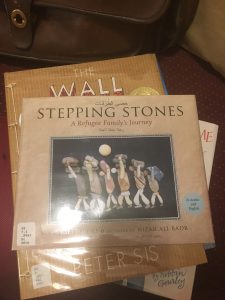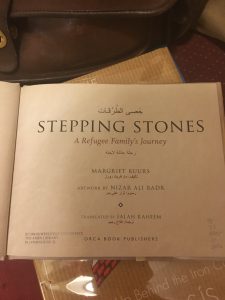Title: Stepping stones: a refugee family’s journey
Author(s)/Illustrator/Photographer: Margriet Ruurs, stonework done by Nizar Ali Badr
Publisher and Year Number of pages: Orca Book Publishers, 2016, 27 pages.
Genre: Realistic Fiction

Descriptive Annotation: The cover features a simple artistic rendering of a refugee family fleeing Syria made out of typical pond stones one could find most anywhere, but done in a way that is culturally sensitive-the artist who made the stone sculptures is from Latakia, Syria, and disassembles his pieces as soon as they are photographed. The author actually went and found him and his work on Facebook, but it took some time to get that process going as far as getting the artwork into the book was concerned. As for the book itself, it is a bilingual storybook (English and Arabic text) that involves the engrossing, yet tragic, story of a Syrian family forced to flee their homeland as a result of the ongoing civil war there (2011-present). Rama, our protagonist, is a boy who is used to his peaceful home life with his mother, father, brother Sami, and his grandpa Jedo being the same for years and years. However, the author notes, “that was then, and this is now” (Ruurs, p. 9). Latakia is the only home he’s ever known, and when the war comes to the village, he and his family must flee the land they love so much with tears in their eyes on foot, then by boat to Southern Europe. The family ends up in Europe and is luckily welcomed with open arms, something not all Syrians could state. It would be beneficial for the reader to read up on why and how the civil war got started, as there isn’t much background knowledge provided in the text and it would help to enjoy this story better. The language is pretty simple, but also profound in its own way when describing the devastating impact of the war on ordinary Syrians, particularly Rama and his family.
Classroom Application: It is an ideal text to teach lessons on the aftereffects and Homefront of wars since too often the media and history books solely focus on the big battles and generals instead of the human impact of war, and its unsustainability for the long run. Good stewardship of those who flee strife and calamity is a must, and the author subtly demonstrates that treating your fellow man with dignity and respect is the way rather than outright militancy and sabotage. The best avenue to pursue is to do as the unnamed Europeans do at the end of the book: “Stay here with us. You will be safe now. No more war” (Ruurs, p. 22). How the children best learn this lesson, of course, would be up to the teacher. The passion shown by the main characters in pursuing their goal of freedom from fear and want is certainly a trait for teaching purposes and could be tied into the Four Freedoms speech Franklin Roosevelt gave during World War II in a history classroom setting. Students could think about laws or supreme court decisions that exist in this country that discriminate, or in the past discriminated, against those who took refuge on our shores, and how to go about changing them.
Linguistic and Cultural Diversity Analysis: Since the book is set in Syria and Southern Europe, the culture of the Mediterranean over the centuries is described to a large extent and would be great for a social studies-type course. The traditions of the Syrian people intermingle with those of the host culture they resettle in, but since they are all from the same region to some extent, it is not as much of an adjustment for them as it was for some: “We have a new home now, a home with new sounds and smells, with smiles and people who help” (Ruurs, p. 23). Even though they weren’t part of the group that originally settled the area thousands of years ago, Rama and his family start to readjust, making themselves at home as best they can. Goodness in oneself and others is also a key component in the book, as that kind of lesson never gets old, no matter what sort of class you are teaching, or in what nation-from the US to Sweden to Syria.

